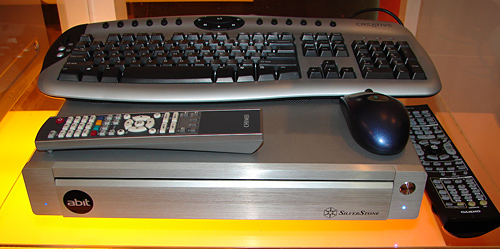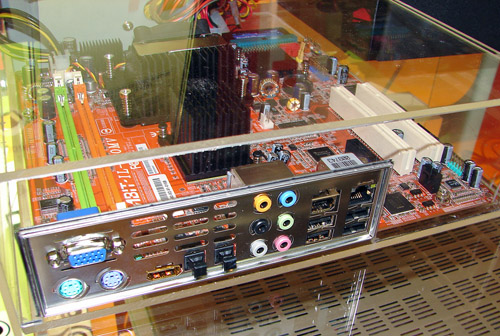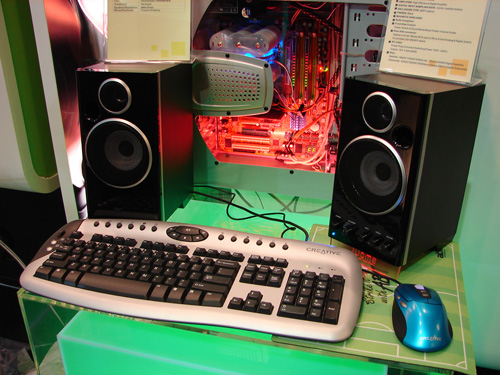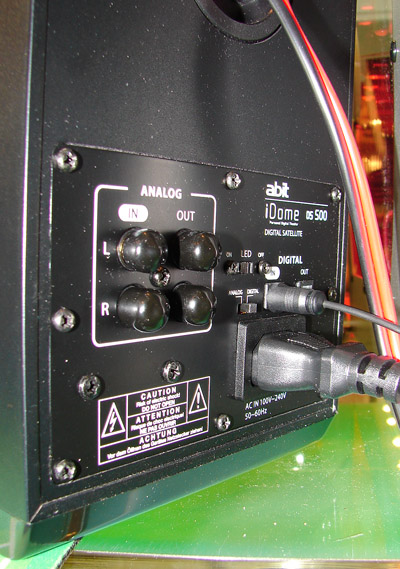Computex 2006: Abit is back, Biostar expands, and Thermaltake dazzles
by Gary Key on June 10, 2006 4:00 AM EST- Posted in
- Trade Shows

Universal Abit is the successor to the Abit motherboard brand, and Abit has partnered with USI for their manufacturing and engineering expertise. The Abit name will remain as the main identity for products but expect to hear more from Universal Abit as the company transitions itself from strictly IT manufacturing to leading technology design and brand management. The new corporate logo above will be on all products with the color of the square over the "i" representing the product brands. Orange will signify the upcoming multimedia products, green for the corporate brands, and dark green for motherboard products. We certainly would have chosen a color such as red for the motherboard group but overall they are trying to erase the last two years of bad memories for the company.
Abit: Multimedia Products

Abit is entering the growing Media Center PC market with their first products that include the ViiV based IL80-MV motherboard and the iDome digital speaker series.

The IL80-MV micro-ATX motherboard is based on the Intel 945GT and ICH7mDH Express chipsets with support for the Core Duo / Solo (Yonah) processor range. Audio support from the Realtek ALC-882M includes full Dolby Home Studio certification, 7.1 channel output, and Optical S/PDIF in and out connections. HDMI output is fully supported by the on-board Intel GMA-950 graphics system. The system is totally silent and in our brief testing appeared to operate extremely cool in the SilverStone case.

Abit is introducing the iDome DS500 speaker and iDome Sw510 subwoofer to the market later this summer. The iDome speakers support a pure digital audio stream process from input to final output, though you can also use them in analog mode if you so desire. The speakers and subwoofer will be sold separately but the 2.1 system on display consisted of two fairly compact speakers, the subwoofer, and an integrated digital amplifier. The cost for the two speakers will be around US $180 and another US $70 will get you the subwoofer. Both units will work with other manufacturers' products although for the price we recommend buying the set.

The back of the right speaker offers the choice of analog or digital input/output, as does the subwoofer. Each satellite offers 25W/per channel with the subwoofer providing 50W. The subwoofer features a 6.5 inch Super Bass driver featuring DBX technology providing a very deep bass tone with extremely little distortion in our listening tests. The satellites offer an independent 1 inch dome tweeter and 4 inch Neodymium drivers in a high quality case.
The speakers are controlled by a unique uGuru chip that allows for six different sound environments to be selected by the user, allowing you to tweak the processing dependent upon the audio stream being played. These modes consist of Normal, Game, Music, Movie, Rock, and Jazz. We had the chance to listen to these various modes before the show started and were very impressed with the satellites ability to deliver a very clean audio stream in a variety of situations from movie playback to gaming. The highs were clear and bright with the mids being very warm while extending downward to the point where there was noticeable bass response without the subwoofer. However, for games and movies we highly recommend adding the subwoofer.










27 Comments
View All Comments
Operandi - Sunday, June 11, 2006 - link
Lian Li and SilverStone need companies like Thermaltake to make ugly ass cases to make theirs look good. ;)Griswold - Saturday, June 10, 2006 - link
Or the all-time classic:Optimus Prime called, he wants his chest armor back!
Lonyo - Saturday, June 10, 2006 - link
Putting passive cooling on their "max" motherboard. It makes me sad.vailr - Saturday, June 10, 2006 - link
Only one PCI slot on Abit's "Top of the Line" board? No thanks. Would need at least 2, or preferably 3 PCI slots.And regarding the passive/heatpipe chipset cooling: these won't work with some of
the Lian-Li mid-tower cases where the motherboard is oriented "upside-down".
Chernobyl68 - Saturday, June 10, 2006 - link
That was my first thought when I started seeing all of the passive cooling solutions out there...how would it work with the Lian-Li case I plan to buy? do I need to reconsider my options? I thought all I was waiting on was an acceptable motherboard to be released before I make my new system but I may be waiting a bit longer.Chern
Gary Key - Saturday, June 10, 2006 - link
We discussed this at length with Abit, too late to change now but we told them there would be a backlash. Also, if you run CrossFire or SLI, that single PCI slot is gone.
LoneWolf15 - Saturday, June 10, 2006 - link
Major case of "Aim gun at foot, pull trigger".
Unless Abit is willing to come up with some high quality PCIe peripherals to match, their high-end single-PCI slot boards are worthless, and releasing them will be a major monetary loss. With Crossfire/SLI, this means no Creative X-Fi (or insert other better-than-onboard-sound-card here), and limited choice of any other peripherals.
Universally stupid.
JarredWalton - Saturday, June 10, 2006 - link
The only major loss is sound card support, as you can currently get Theater 550 TV Tuners in PCIe format. I'm personally finding onboard audio sufficient for my needs, especially with the latest HDA solutions. X-Fi sounds better and cleaner, but it's not something you really notice unless you have really nice speakers/headphones.It's sort of like integrated NICs - is there anyone out there that really cares about the difference between 700 Mbit vs. 950 Mbit GbE performance? The only time I touch those speeds is when doing theoretical tests; HDD speeds are the limit otherwise, and gaming? Don't make me laugh: games don't even stress a 10 Mbit Ethernet connection in most instances, and certainly don't need more than 100 Mbit.
Anyway, my point is that integrated audio is fast nearing the point where few people worry about add-in sound cards. Get some digital speakers and use the S/PDIF connections on nice motherboards, and I'd love to see some people do a "blind" listening test. I'm sort of curious about what percentage of our readers still use add-in sound cards - I would be surprised if it's more than 10%.
Odeen - Tuesday, June 13, 2006 - link
There are a few problems with onboard audio. The sound quality is one of them. The second problem is the PERFORMANCE hit and the 3d sound rendering features available.Basically, onboard audio (and outboard audio processors without hardware DS3D and EAX support can emulate EAX, but not perfectly. EAX 4.0 is a no-go at all. And this emulation is tantamount to doing software 3D rendering - it's very slow, especially when dozens of sounds need to be located in 3D space and processed.
Any gamer owes it to himself to use a sound card capable of 3D sound processing, or they're cheating themselves out of frame rates.
BPB - Saturday, June 10, 2006 - link
Did they really think that people running Crossfire setups wouldn't at least want better-than-onboard sound? That alone is one PCI slot. The onboard sound looks good, but is it that good?